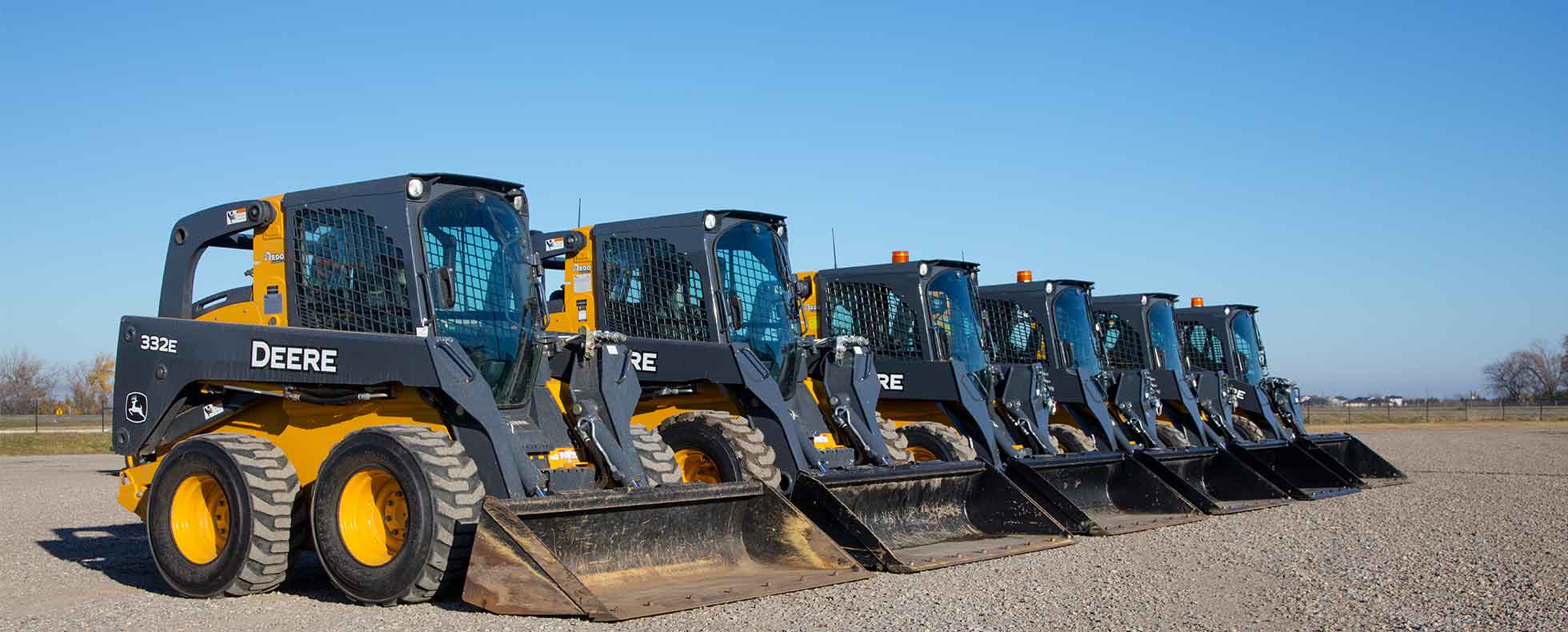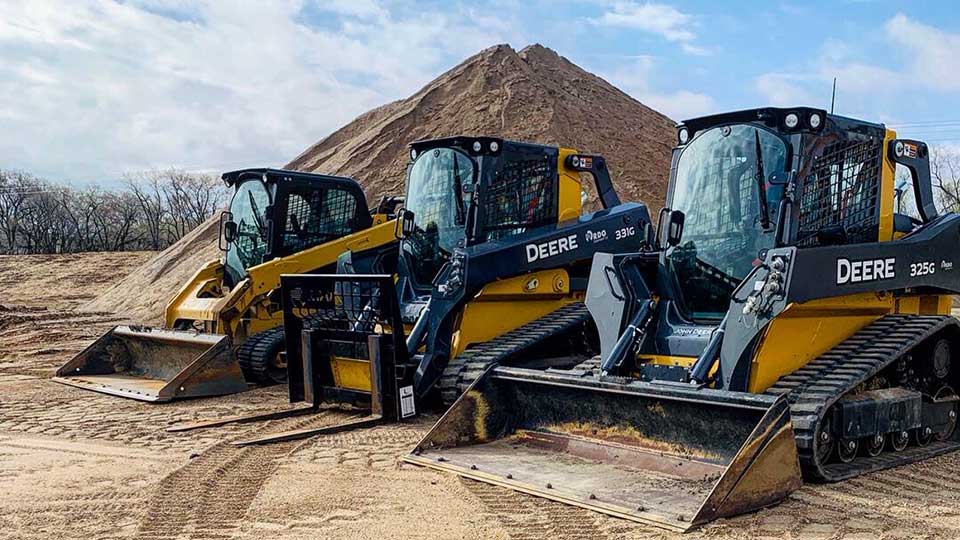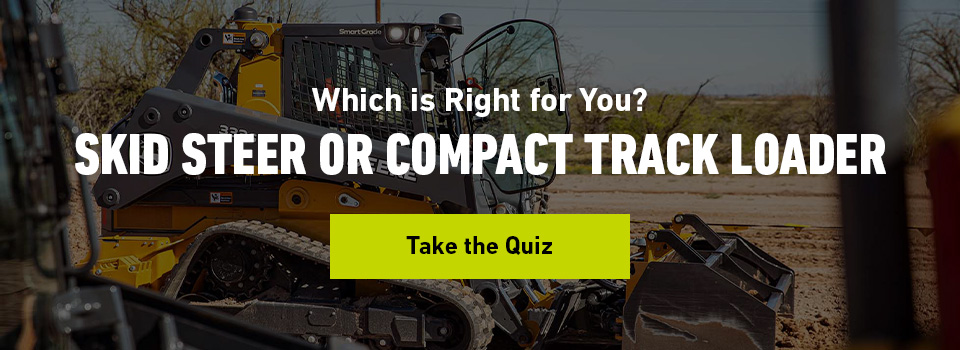
Whether you’re designing and installing gardens, patios and walkways, providing lawn care services like mowing, fertilization, tree planting and aeration or xeriscaping, you rely on your fleet of equipment every day.
This is why buying a new (or used) compact loader is a big deal. You have deadlines to meet, a budget to manage and people depending on you.
Although your needs are unique, you can still find the perfect equipment solution for your landscaping business.
Here at RDO Equipment Co., we’re proud to partner with and support landscaping companies in Texas every day. We’ve identified what kinds of John Deere compact loaders (skid steer and compact track loaders) other landscaping companies tend to purchase, and outlined some factors you should consider to make an informed decision.
Over the past decade or so, compact track loader sales slowly caught and began to outpace wheeled skid steer sales among Texas landscapers.
Today, compact track loaders are far more popular than wheeled skid steers, representing nealry 80 percent of industry sales in 2024. As they’ve progressed, compact track loaders have become increasingly suited to meeting the needs of Texas landscapers.
Track loaders offer better traction and stability, which are crucial for pushing dirt and performing other heavy-duty tasks in uneven, often muddy, terrain.
Now that we’ve identified compact track loaders as the more popular option for Texas landscapers, the next question you may be asking is which one you should consider.
John Deere’s compact track loaders come in these variations:

Over the last 12 months, here are the most popular John Deere compact track loader models among landscapers in Texas:
The 325G is consistently the top compact track loader model for landscapers, for several reasons.
The main factor landscapers choose the 325G is its maximum horsepower without the need for a diesel exhaust fluid (DEF) system, making it both powerful and efficient.
The 325G is a mid-frame model that operates like a large-frame skid steer and is capable of handling high-flow attachments such as mulching heads, augers, mowing decks and Harley rakes.
That said, while landscapers in your area prefer the 325G, you must determine if it suits your needs. Here are some tips to help you select the best skid steer (or track loader) for your tasks.

You know your business best. As you consider the tasks you need to accomplish across your job sites, you can’t worry about getting them done on time.
That’s why you need a versatile machine equipped to handle everything from moving dirt to mulching to digging holes.
In total, John Deere’s new compact construction lineup has five compact track loaders and six skid steer loaders. Consider these three factors when choosing a make and model:
Landscapers in Texas clearly prefer track loaders over wheeled skid steers. Compact track loaders perform better on soft, muddy or uneven terrain, while wheeled skid steers excel on hard, flat surfaces like concrete or asphalt.
Your first task is to consider the type of terrain you work in.
For example, companies focused on grading, trenching or moving heavy materials across soft or uneven terrain will benefit from a compact track loader. The tracks provide better traction and stability, especially on muddy or sandy job sites, which are common in new construction or irrigation installs.
These machines also excel in wet or hilly environments, making them ideal for year-round use in variable Texas conditions.
On the other hand, if the bulk of your work involves hardscaping, hauling mulch or prepping patios on firm ground, a wheeled skid steer might be the smarter choice.
They’re faster, more maneuverable, and less expensive to maintain — perfect for urban jobsites or residential neighborhoods with paved access.
Task Type / Jobsite Condition | Recommended Skid Steer Type | Why It Matters |
Grading, trenching, or heavy lifting | Compact Track Loader (CTL) | Tracks offer better traction and stability on soft or uneven terrain. |
Working in muddy, sandy, or wet areas | Compact Track Loader (CTL) | Lower ground pressure prevents sinking and turf damage. |
Operating on hills or slopes | Compact Track Loader (CTL) | Tracks provide enhanced stability and reduce the risk of tipping. |
Hardscaping on paved or compact surfaces | Wheeled Skid Steer | Wheels are faster, more maneuverable, and cause less wear on hard surfaces. |
All-weather, year-round operation | Compact Track Loader (CTL) | Performs better in snow, rain, and variable conditions. |
The second factor your company should consider is what kind of tasks you will be using it for.
For companies focused on heavy-duty applications like moving large pallets of sod, lifting stone for retaining walls or operating high-flow attachments like trenchers, augers, power rakes, mulchers and planers a larger skid steer with higher horsepower (70+ HP) is often the best fit. If you plan to use high flow attachments all day (without overheating or slowing down) an even larger model (90+ HP) may be necessary.
These machines offer more hydraulic power, greater lift capacity and better stability under load — critical for jobs that demand strength and endurance.
Here are your options if this is your need:
Machine Type | Model | Horsepower (HP) |
Compact Track Loader | 325G | 74 hp |
Compact Track Loader | 331P | 98 hp |
Compact Track Loader | 333P | 108.5 hp |
Compact Track Loader | 335P | 118 hp |
Skid Steer | 324G | 74 hp |
Skid Steer | 330P | 98 hp |
Skid Steer | 334P | 118 hp |
On the other hand, landscapers who specialize in residential work, light grading or mulch and soil transport may find that a smaller, mid-frame skid steer (50–65 HP) offers the perfect balance of power and maneuverability.
These models are easier to transport, more fuel-efficient and better suited for tight spaces like backyard gates or urban job sites.
Here are your options for lighter duty needs:
Equipment Type | Model | Horsepower (HP) |
Compact Track Loader | 317P | 65 hp |
Skid Steer | 316P | 65 hp |
Skid Steer | 318P | 64 hp |
Skid Steer | 320G | 69 hp |
Consider your budget and the features you need on your skid steer. Price ranges greatly across John Deere’s compact loader lineup from $50,000-$140,000+.
Since you know the capabilities of your current fleet of equipment, you understand the kinds of tasks your new tool will perform and the type of terrain it will be used in. With this in mind, find the perfect machine for your budget.
Buying a skid steer will cost less than buying a compact track loader.
Here’s how the comparative models stack up in general starting price:
Skid Steer | Compact Track Loader Model | General Starting Skid Steer Price | General Starting Compact Track Loader Price |
316P | 317 P | $45,000 | $62,000 |
324G | 325G | $59,000 | $72,000 |
330P | 331P | $64,000 | $79,000 |
334P | 335P | $99,000 | $122,000 |
For more specific information on what you can expect to pay, build and price your own machine here.
Choosing the right skid steer or compact track loader for your Texas landscaping company means balancing terrain, tasks and budget.
If your projects involve heavy lifting, trenching, mulching, or running high-flow attachments all day, you’ll want to consider a model with 70+ HP — or even 90+ HP for maximum performance and durability.
Compact track loaders like the 325G or 333P offer the traction and stability needed for soft or uneven terrain, while wheeled skid steers like the 324G or 330P are ideal for hardscaping and urban jobsites.
And if your work is more residential or seasonal, a mid-frame model like the 317P or 316P may offer the perfect mix of maneuverability and efficiency.
Ultimately, the best machine for your business is the one that fits your jobsite conditions, supports the attachments you rely on and aligns with your budget.
Whether you’re scaling up your fleet or buying your first loader, RDO is here to help you compare models, demo machines and make a confident, informed decision. Find your local RDO store.